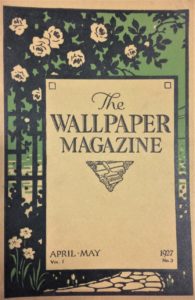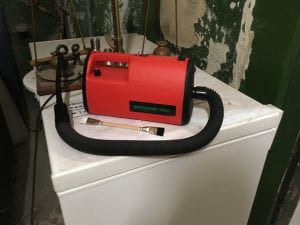Maria Paganopoulou, MA History of Design and Material Culture, shares her research on a Victorian textile political portrait.
As a part of the MA module, Exploring Objects, students are required to select an item from the Dress and Textile History Teaching Collection at the University of Brighton. The task is to uncover its original history and to provide further interpretation. Since my knowledge of dress theory was still scarce at the point I undertook the module, I went for an object for which my background studies in the history of arts and crafts had already prepared me. This object was a framed silk image, a Stevengraph, depicting the British Prime Minister from 1868-1994, William Ewart Gladstone (fig.1)

1. The front of the Stevengraph (left) and its reverse (right). Stevens Company, Right Hn. W. E. Gladstone, Silk Picture, The Dress and Textile History Teaching Collection, University of Brighton, Photograph by Maria Paganopoulou, October 2019.
For the uninitiated, Stevengraphs were popular mid-nineteenth-century silk images, produced on a Jacquard loom which enabled multiple reproduction. Their name derives from their inventor, Thomas Stevens. Due to their mass production, I was able to locate a sibling to the Dress Collection example in Herbert Art Gallery and Museum in Coventry.
The Stevengraph was extremely visually interesting to me as it seemed to combine contradictory elements of seriousness and playfulness. Gladstone’s sombre expression, woven in black and white, was combined with sparkling threads and colourful flowers. These seemed incongruous, even comic.
My mystery object became less mysterious when I explored existing scholarship, such as that of Geoffrey Godden, who has comprehensively investigated the original contexts for Stevengraphs as a specific Victorian category of decorative objects. Stevengraphs were also used as a case study by anthropologist Michael Thompson in his 1979 book, Rubbish Theory: The Creation and Destruction of Value. Thompson amusingly thanks Godden for relieving him ‘of the tedious task of having to collect most of the historical data before analyzing them’.

2. J. Russell & Sons, The Right Hon. William Ewart Gladstone, c. 1880, albumen cabinet card, National Portrait Gallery: Photographs Collection Database, April 2020 © National Portrait Gallery
My first step in Stevengraph data gathering and analysis was to locate my object in space and time. Stevens’ company was based in Coventry and according to Godden’s rigorous dating method, based on fonts and frames, the birth of my object took place in that town between 1889-1891. As the image prepared for the loom was most likely not drawn from life, my next step was to search for its visual source.
After lengthy research in the digitised collections of the National Portrait Gallery (NPG), I was able to locate the original image, a nineteenth-century photographic cabinet card (fig.2). The striking similarity between the photograph and the Stevengraph did not leave much room for doubt and the interplay between the two nineteenth-century technologies, photography and mechanical loom, prompted me to find out more connections between them.

3. William Thomas Brande, Antoine Claudet and Michael Faraday, half plate daguerreotype, c. 1846, National Portrait Gallery: Photographs Collection Database, April 2020 © National Portrait Gallery
After examining previous types of photography in the online catalogue of the NPG and various books dedicated to the subject, I discovered many similarities in the way that photographs and silk images were framed. The bell shape of the frame can be found supporting various kinds of early photographs, including Daguerreotypes and Ambrotypes (fig. 3) and also later cabinet cards.
Furthermore, the way that Stevengraphs were framed has affinities to cabinet cards kept in albums (fig. 4), suggesting a similar use and display. It is evident then, that although made in silk, a luxurious material often associated with fashions to be worn on the body, Stevengraphs were produced and framed to be visually consumed, as with parallel display patterns in photography.

4. Framed Cabinet Cards, Four Reproduction in Asa Briggs, A Victorian Portrait: Victorian Life and Values as seen through the Eyes of the Work of Studio Photographers, London, Cassell, 1989, pp. 18-19 (upper), 82-83 (down). Print
The time had come to investigate my initial excitement about the Stevengraph’s apparent contradictions. I learned that seriousness in the sitter was not surprising in the period. Indeed, it is not usual to find smiles in Victorian photographs. Smiling in photographs is a cultural convention established in the twentieth century due to the popularisation of informal photography by Kodak.
In addition, although politicians today brand themselves as approachable and even light-hearted, in nineteenth-century England seriousness was expected in the political arena. Nevertheless, humour had a distinct place in Victorian politics, with a special class-specific aspect especially reserved for mocking those of a non-aristocratic descent. Gladstone, having mercantile origins, was frequently lampooned by fellow politicians and cartoonists (fig. 5). It has been argued that his political persona was based on being consistent and serious as a way of refuting such attacks. This seriousness was also reflected to the way he styled himself when being photographed.

5. Harry Furniss, William Ewart Gladstone, pen and ink, 1880s-1900s, National Portrait Gallery: Primary Collection Database, April 2020 © National Portrait Gallery
As far as the other side of my seeming paradox is concerned, namely the colorful flowers of the image, they lost some of their playfulness when I learned that they are the official symbols of England (rose) and Scotland (thistle) respectively. Gladstone was half Scottish and had run a successful campaign in the Scottish province of Midlothian. It may even have been that this campaign gave rise to the production of objects depicting Gladstone in the first place.
This brought me to the matter of the object’s consumption. Stevens’ marketing strategy for his silk pictures promoted technological innovation as their main selling point. No explicit reference was made in advertisements to their visual subject matter. As a result, I had to turn to other sources. What emerged from further research was Gladstone’s carefully cultivated popularity, especially in the context of the Midlothian campaign which is considered to be one of the first modern political campaigns.
Popular admiration for Gladstone resulted in the production of an abundance of objects carrying his likeness, from figurines to printed plates (fig. 6). His popularity has been described as equivalent to a cult. This provides a framework for understanding why the Stevengraph might have been purchased and how it might have been used. It may have been bought to express admiration, and may have been placed in a photographic or souvenir album amidst other beloved political and public figures, whose likenesses were also issued.

6. Gladstone Plate, porcelain, in Asa Briggs, “Victorian Images of Gladstone”, in Peter J. Jagger (ed.), Gladstone London, Hambledon Press, 1998, pp. 3. Print
To conclude, the range of research directions that a single object can open up was far more than I had first anticipated. The variety is what made the research fascinating. Stevengraphs existed in a wide network of objects and people, the study of which opened new windows for me into Victorian visual culture, design and politics.
*My title refers to the article by Joseph S. Meisel (1999), ‘The importance of being serious: The unexplored connection between Gladstone and humour’, History 84:274, pp.278-300.
For more information about Stevengraphs, see Herbert Art Gallery and Museum: https://www.theherbert.org/collections/social_and_industrial_history/18/stevengraphs
Website featuring ‘all known silk bookmarks, silk pictures and silk postcards manufactured since 1862’: http://www.stevengraph-silks.com/













































